Month 9:22, Week 3:7 (Shibi'i/Sukkot), Year:Day 5955:258 AM
2Exodus 9/40
Gregorian Calendar: Thursday 15 December 2022
Book of Revelation XL
The Mystery of the Court of the Gentiles
with a Word on Christmas & Hanukkah (Rev.10-11)
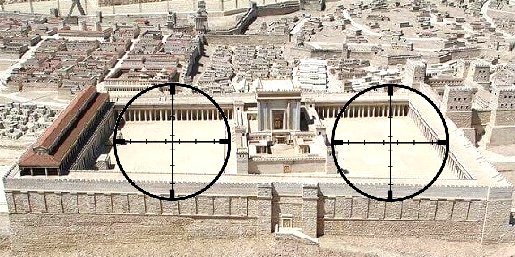
Continued from Part 40
Introduction
Shabbat Shalom kol beit Yisra'el and Mishpachah and welcome back to our in-depth study of the 39th part of the Book of Revelation. Today we are going to pull over, as it were, and take a break from our journey in order correct a wrong assumption I made, and to thereby, I hope, solve a persistent riddle. I believe you will find the material we are about to cover today exciting and informative as we go about the believer's business of digging for more and more light and truth from the Davar (Word). We shall resume the 7th Shofar (Trumpet) and 3rd Woe next week, Yah willing. In the meantime we must return to the first two verses Chapter 11 concerning the Court of the Temple (yes, they're that controversial!). It reads:
"'Rise and measure the temple of Elohim (God), the altar, and those who worship there. But leave out the court which is outside the temple [complex], and do not measure it, for it has been given to the Gentiles'" (Rev.11:1-2, NKJV).
Overview of Chapters 10 & 11 - Human Prophetic Channels
Before we do that, we need to make a very quick summary of last week's material and to pose a very important - and interesting - question that will shed yet more light on what, I think, we agreed was the hardest segment to understand of the whole Book of Revelation so far. Between the 6th and 7th Shofars (Trumpets) - the second Interlude - our attention has been focussed on the human channels through which the divine revelations are communicated. The key word in chapters 10 and 11 has been 'prophecy!' (the verb, as opposed to prophecy) (Rev.10:11; 11:3,6). At the beginning of the Messianic Æon (Age), John on the island of Patmos is the navi (prophet) prophesying; at the end of that same Æon (Age) there will be two 'witnesses' who will prophesy in the city of the very end-time Jerusalem.
Two Strong Malakim and Impending Disaster
When the two 'strong' or 'mighty' malakim (angels) apppeared in the text, there was a sense of impending disaster. The terrible truths uttered by the first in a thunderous voice were for John alone and had to be sealed up - he wasn't to communicate them to anyone else or write them down, reminding us of an incident in which Paul tells of a man whom he had once known who "was caught up into Paradise and heard inexpressible words, which it is not lawful for a man to utter" (2 Cor.12:4) for, you see, he might might, in certain cases, inadvertently make make them happen ahead of the divinely ordained time... such is a power and authority of an authentic navi (prophet) operating in his office!
Some Things to Be Seen but Never Spoken Of
In other words, some things are to be seen but never spoken of. The second mighty or strong malak (angel) announced that there would be no more delay in the build-up of events - the 7th Shofar (Trumpet) is going to be the climax of at least the second cycle (though there are, you'll remember, those who believe that these three cycles (consisting of seals, shofars and vials) are all the same set of events but described in other ways, so for them, on this occasion, this is the 'end-of-ends' being described in a 'second way').
The Bitter-Sweet Lesson
The last and worst part of the 'bad news' is about to be given. It is on a 'little scroll which John is told to eat and digest, first tasting sweet and then bitter as the truth sinks in and is thoroughly digested, not unlike the reaction many readers of the Book of Revelation have when confronted by the sober reality of its contents. John is told to 'prophesy again', thereby initiating on earth the events spoken of in heaven, and to continue his work of foretelling the future of the world. Which brings us to an important point we didn't cover last week or the week before, which I hope will be an object lesson in the importance of carefully assessing any assumptions we make when interpreting a scriptural text, particularly a complex prophetic one.
An Erroneous Assumption About the Temple 'Outer Court'
You will recall that John is shown around the city of Jerusalem and its temple - we'll not concern oruselves here whether this is to be taken literally or figuratively. He measures the temple but not the court. You will remember that the Tabernacle of Moses in the wilderness, and that of David after the Conquest, consisted of a Tent or Tabernacle divided into two parts - the Holy Place and the Holy of Holies - surrounded by an outer court which was itself fenced off from the noutside world where those not of the Priesthood gathered nearby. Together these three constitute the 'temple complex'...or even 'temple' for short. Make a mental note of that. Beyond that lay the desert or unhallowed (unholy, profane) ground.
The Temple, Temple Complex and Court
I have been making the wrong assumption that this court was this temple-complex's inner court which John did not measure because in the original Tabernacle it was the only courtyard; and I cited support of that assumption by pointing to the unusual wording of the Greek text that speaks of - not the whole Tabernacle or Temple (Hieron in Greek) - but just the 'Holy Place' or Naos in Greek. From that one assumption a succession of theological ideas flowed that were off-target. Indeed, I assumed that the Greek text was somehow superior to the Aramaic one on this one (unique) occasion (the 'exception' to the rule) which I then assumed had somehow been corrupted by the Aramaic. But what if the Aramaic text was, in fact, the accurate one (an assumption based on the thesis I've been pushing for many years now) that the bulk of the New Testament was originally received in Aramaic (the 'original' inspired text)? This is a critically important assumption and one we need to thoroughly research and is, accordingly, very controversial, putting a division between the supporters of Hebraic and Greek primacy, meaning those who put the Aramaic or Greek ahead in authority of the other because it was the language in which the revelation was originally recorded.
Problems That Translators Face
What if the Aramaic was was, after all, as I've been saying now for so many years, the inspired text too here and the Greek translator make a wrong assumption or two of his own in his choice of words? Translators do, after all, as we've seen numerous times when a single word in a language can mean one of two different things with a wrong choice seriously influencing the belief and practice of a whole denomination - think back on the Aramaic word that can mean either a 'believer' or a 'eunuch' (Mt.19:12), or another which can mean 'camel' or 'rope' (Mt.19:24; Mk.10:25; Lk.18:25). Which is the translator to choose? The Aramaic speaks of the 'temple' or 'tabernacle' as the WHOLE THREEFOLD TEMPLE AREA which would INCLUDE the Holy of Holies, the Holy Place and the Outer Court! That being so, then in John's Revelation about that 'Outer Court' - the original 'Outer Court' of Moses' Tabernacle - was NOT trampled by the Gentiles at all because John never emasured that. This is critical because you may remember I shared a vision with you of our Headquarters having its seals or signs ripped down because our own 'outer court' (represented by our garden or yard) had been invaded by the Enemy.
Allowing the Enemy a Free Ticket In
What if I had made a false assumption about the meaning of Revelation 11 and unwittingly allowed the Enemy onto our own turf by assuming it's 'invasion' and 'trampling' was inevitable and so allowed the Enemy to cause confusion about whether we had been rejected or not? This has been the troubling question I have been facing this last week.
Learning from My Mistake
In case you hadn't realised, I am confessing an error of judgment here. Unfortunately it happens. And the reason I am backtracking on what I said over the last two weeks is not out of some hurried sense of 'damage control' to save face but because I want us all to learn from mistakes. It's why Scripture records the mistakes of Yahweh's servants like David and Solomon, for instance. Accordingly, I am not going to edit my error out of the last two week's sermons but rather leave it in and add an explanatory footnote pointing to my message today as an object lesson for all of us.
The Numerous Courts of Herod's Expanded Temple
So what I want to do now is share with you what Yahweh showed me about the actual temple court that was trampled by the gentiles because it was not the Mosaic or inner Davidic court that was trampled! You see, when Solomon built his temple, and when Zerubbabel restored a smaller version of it after the Babylonian Exile, and then when Herod greatly expanded it after the Maccabbean débâcle, Solomon's and Herod's temples went far beyond the original plan of the Moses Tabernacle given to Moses. I have a series of books which some of the scholars among you might find interesting by Kevin J. Conner that explain these differences that you'll find listed in the Acknowledgements section on the website article. You see - and this is the key point and a reminder of the importance of doing careful history - the temple that John had been familiar with growing up was Herod's temple, as also that of his contemporaries up until its destruction of AD 70. And that temple had not one, but several, courts, one of which was pointedly known as the 'Court of the Gentiles'.
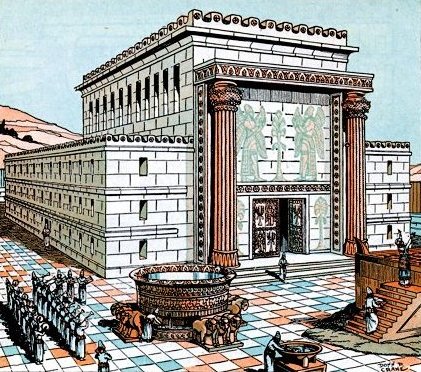 Solomon's magnificent temple designed, in part, by his father
Solomon's magnificent temple designed, in part, by his father
David showing the Altar, Brazen Sea and two entrance pillars
Introducing Herod's Temple
On the screen (see image below) you will see a map of Herod's Temple as it was in the first century - to be exact, this was the second Herodian Temple rennovation project which the Herodian kings spent lavishly on in order to curry favour with the people whom they knew 'knew' they were illegitimate puppet kings installed by the Romans and not descendants of David. The blue area was the original design used by Moses and David - the first tabernacle containing all the essential elements - the Holy of Holies, Holy Place and Outer (or Priests') Court. The red area contains the additional areas, first, added by Solomon (designed by David) and then by the Herods. Everything within this area was kosher (pure) and according to divine tavnith or pattern. You will see the Temple-proper (which I have put a menorah over) containing the 'Holy Place' (at the bottom) and the 'Holy of Holies' at the top. Surrounding that is what by then came to be called the 'Priest's Court' or 'Outer Court' or simply 'Court' in the original scriptural descriptions. Everything outside the red boundary was blasphemous which I have marked with circled pentagrams.
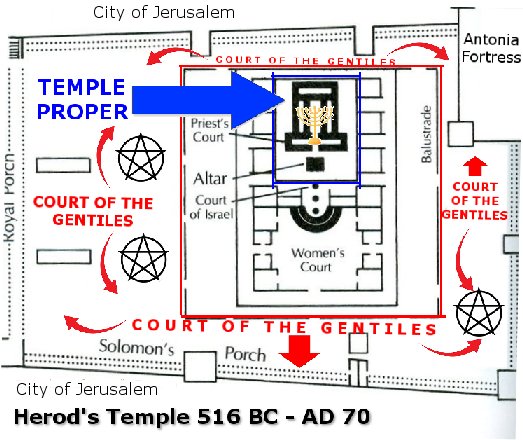
Courts of Confusion
In addition to the 'priests-only' court of the Temple-proper (known, as I just said, in New Testament times as the 'Court of the Cohenim (Priests)') which contained the Altar of Sacrifice and the Brazen Lava (only the Altar is shown in the diagram), there were three or four extra courts, namely:
- 1. The Court of the Priests (the only court in Moses' Tabernacle, called by Ezekiel the 'Inner Court');
- 2. The Court of Israel (designed by David and built by Solomon - the 'outer court' of Ezekiel's temple);
- 3. The Court of Women (added by the Herods);
- 4. The 'Outer Court' (as it was then called in the first century AD amidst collonades...added by the Herods, where it says 'Balustrade' in the diagram); and
- 5. The outermost (or 'outer') Court of the Gentiles (added by the Herods).
What is 'outer' or 'outermost' will then depend on which temple you are looking at.
Who Was Allowed into These Courts?
The people who were allowed into these five courts were, respectively:
1. Cohenim (Priests);
2. Israelite/Judahite men (in Solomon's day women were allowed here too);
3. Israelite/Judahite women (a restriction on women imposed by the Herods)
4. Israelite/Judahite men and women (the Balustrade); and
5. Non-Israelite/Gentiles.
The Problem of the Ballustrade
There is some dispute as to whether the Balustrade was a true court or not - it was the innermost of two collonaded areas that surrounded the whole temmple complex, a line which Gentiles could not cross, where Israelite men and women freely mingled. Indeed archaeologists have found a stone inscription from the area in Latin and Greek forbidding Gentiles to go any further. Yah'shua (Jesus) and the apostles frequently taught in these two areas. Israelite men - Levites and non-Levites - had to pass through the Women's Court to get to their own 'Court of Israel' and thereafter only the Levites could pass into the priestly area represented by an Outer or Priest's Court (containing an altar of sacrifice, brass laver or 'sea' and two pillars at the entrance - the pillars of Jachim and Boaz) and Temple building-proper with its two sacred rooms - the Holy Place and the Holy of Holies.
Deceived Because of a False Assumption Based on Incomplete Information
The point is this - and it's a critically important point to our proper understanding of chapter 11: John, when he measured the 'temple', would have been measuring the Holy Place together with the Outer Priests' Court because the two are essentially linked together as one temple-complex - you cannot divide off the Priest's Court from the Holy Place and still have a functioning Temple! The whole priests'-only area is therefore the 'temple'. This constitutes the 'Temple proper' marked in blue on the diagram. Had the Gentiles actually been trampling the Priest's Court (what we have hitherto wrongly called the 'Outer Court') they would have effectively brought Temple- (and therefore Yahweh-) worship to an end. They would have gained access to Divine Space as happened in my vision of our home leading to the ripping down of the signs on the outside entrance way of the building here. Because I had carelessly let the enemy in to the courtyard of our home, falsely thinking such was inevitable based on my faulty understanding of Scripture, he both gained access to our 'outer court' and ripped down the signs on the outside to convince me he somehow had 'de-sanctified' the inside too...when, in fact, he had failed to get in, as the vision showed. So may this be a warning to all of us to do careful research and informed Scripture study, for none of us are immune to error. As it is written:
"For," as Yah'shua (Jesus) said, "false messiahs (christs) and false nevi'im (prophets) will rise and show great signs and wonders to deceive, if possible, even the elect" (Matt.24:24-25, NKJV; Mk.13:22).
We Have to Be So Careful - My Repentance
We all of us have to be so careful. Mistakes will be made, yes - that's unavoidable because we're fallible - but we must be sufficiently alert and humble enough to admit those mistakes when we discover them, repent, and quickly fix them. And that is what I am aiming to do today. As a teacher, the greater burden of responsibility falls upon me to get this right, so I hope you will forgive me and accept that I am setting the right example today. We cannot afford to let pride get in the way and so perpetuate error. We're still going to redecicate everything next year though I have already reclaimed our 'courtyard' and cleansed it.
A Critically Important Piece of Historical Information
With this critically important piece of historical information now in our hands, then, we can now be certain that when John measured the 'Outer Court' which in John's prophecy was given over to the Gentiles to trample for 3½ years, he was specifically measuring the outermost 'Court of the Gentiles' of the Herodian Temple, not Moses' Tabernacle nor, indeed, David's or Solomon's - the court that was trampled (the name 'Gentiles' is the glaring clue here), leaving unpolluted the Temple-proper. It makes perfect sense that John's illustrative Temple reference would have been to the Herodian Temple which he had grown up with and intimately knew (or had known 20 or so years before he penned the Book of Revelation after AD 90), along with most of his older readers and listeners having the same exposure just as when we speak of Coventry Cathedral in England today it is the moden one and not the older one destroyed in the Blitz which was before my time.
A Picture of Apostacy
Now, as I said, I am going to leave unchanged, save for a clarifying footnote, my error about the Outer Court, as an object lesson on how critically important our assumptions are because I can't underline this enough. If any part of our 'temple' is compromised, then it is our own sinning or negligence that has caused it. We cannot blame the 'Gentiles' or the world as a whole, because sinning gives the Enemy legal rights to begin 'trampling' us - first our 'outer' or 'priestly court' (our first layer of protection where we do our cleansing) and then, if we do not repent but allow sin to have its continuing hold, our 'Holy Place' (leading to our stopping to worship and pray) and finally - if we are foolish enough to let it go even beyond that - our 'Holy of Holies' too which symbolically amounts to abandoning Elohim (God) altogether and embracing, first, agnosticism, and then atheism. This, then, is a picture of apostacy which starts with being careless and then progressing to more and more rebellion until we can no longer feel Yahweh's presence anymore - rebellion that causes forgetfulness and thence to false reasoning based upon more and more false assumptions about reality, itself leading to the false conclusion that there is no God because we can't feel Him now. This is what postmodernists call 'deconstruction' only they go about this process deliberately and not subconsciously.
A Shocking Experience
This whole experience has actually quite shocked me and initiated a deeper repentance in my life and led to some big changes internally already. We haven't actually been rejected as a ministry but we (but principally myself) have compromised somewhat and sinned that has let the Enemy in beyond our first line of defence which in turn has led to further compromises. That I am going out of my way to redress in my future teachings, so expect to be jolted more than usual!
Why Did Herod Build This Gentile Court?
Which leads me to an even more interesting question: What was a 'Court of the Gentiles' doing in Herod's Temple in the first place? There is no revelation anywhere in the Torah commanding all these extra courts to be built, not by Moses or any later nevi'im (prophets), and whilst David's Court of Israel does not contradict divine tavnith (pattern) in any way and is a logical progression from Moses' revelation by David, these other 'courts' were never commanded by Yahweh at any time. They are the invention of men. That David was inspired in adding a Court of Israel is actually confirmed by Ezekiel's Vision which includes such an area which he calls the 'Outer Court' (see diagram below):
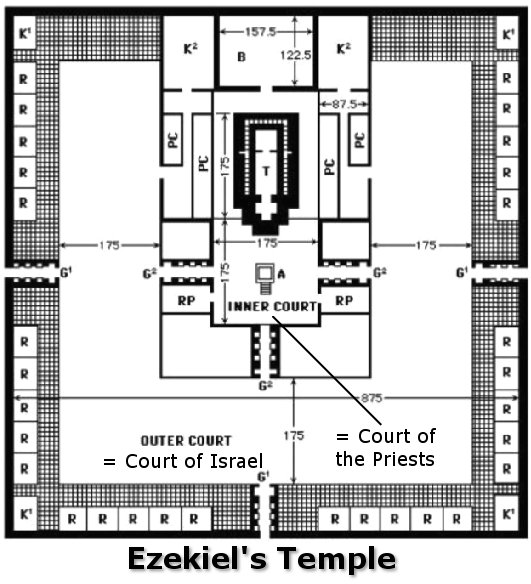 for Judah and Israel in Exile if they repented
for Judah and Israel in Exile if they repented
not any imagined 'Millennial Temple'
Two Possible Explanations
So what was this Herodian 'Court of the Gentiles'? Who was it for, and why? Once we know the answer to these questions we can then probe its spiritual meaning and significance in Chapter 11. Without any a priori historical knowledge about its purpose, two possibilities spring to the uninformed mind (which oen which may be correct...or not):
- 1. It formed part of the Pharisee apartheid system of keeping Gentile converts separate from Judahites/Israelites by putting them, essentially, in an inferior, servant- or second-class position to remind them, according to their false system, that Gentiles remained inferior after conversion to Israelites, though this was never the case anciently in Israel; or
- 2. It was introduced by the Pharisees and their Edomite, pro-Roman and compromising patron King Herod, as a sort of ecumenical act on his part...or something like that...for you will recall Herod's elaborate expansion of the Temple occurred under the watch of Israel's new master, the Roman Empire, whose boots he licked and on whom he was dependent for his position. The proximity of the Antonia Fortress containing the Roman garrison, looking down into the Temple compound, illustrates this careful surveillance by the occupying force to ensure Roman interests and security were being maintained, with which Herod had to cooperate.
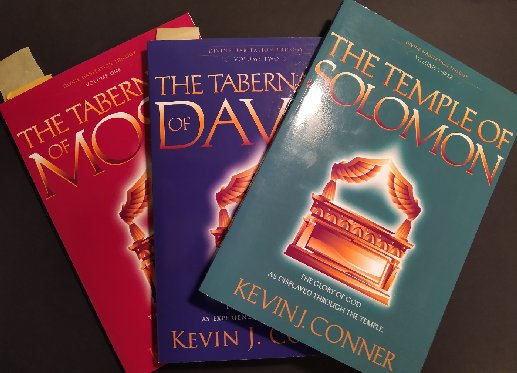 Recommended books for serious students of the Temple of Yahweh
Recommended books for serious students of the Temple of Yahweh
More Questions
Either of these two would then explain why this 'final Jerusalem' in chapter 11 is closely identified (symbolically) by John with Rome, and why the Gentiles are able to trample the whole of the end-time earthly Jerusalem...minus the threefold temple-complex. For an unholy, even blasphemous, extra court round the temple would, in effect, cut off the rest of the city from the Temple-proper and therefore from divine protection, rendering the city beyond the Temple 'unholy'. But which, if either, of these two possible explanations is true? Might there be other possible historical reasons for this biblically unscanctioned court's existence? As a matter of curiosity, let me have a show of hands - how many think it was a court for gentile converts? ... (none) How many for unbelievers as a kind of ecumenical gathering place? ... (none) How many think it might be something else? ... How many don't know? .... OK.
More on Ezekiel's Temple
OK, so here are the facts that we have now established. There was no 'Court of the Gentiles' or 'Court of the Women' in Solomon's temple designed by David, nor in Ezekiel's vision of an aborted Temple. Both of these 'new' courts were creations by pretender king Herod. Unlike Moses' Tabernacle, though, in Solomon's there was a Court of Israel for non-Levites, men and women (so no segregating of the women as in orthodox Jewish synagogues) which Ezekiel calls an 'outward court' (Ezek.40:17; 46:21; 2 Chr.7:3; 4:9). In his vision, there were several gates to this 'Outward Court' - the people who came in one gate could not leave by the same gate but only by the gate immediately opposite the one they entered (Ezek.46:9). So if they entered by the north gate, they had to leave by the south one. This court was, by the inspiration of David who designed it, to allow the people to partake of the Temple complex for thanksgiving and praise close to, and in view of, the Temple-proper relatively close-up. Uncircumcised people could not enter the Court of Israel, circumcision being the mark of identity in the Old Covenant of Yahweh's set-apart people.
The Reason for Herod's Extra Court
Herod, in effect, added an 'extra court' for the uncircumcised, unbelieving, pagan non-Judahites. They were not converts. In fact, a circumcised Gentile convert was still regarded as a proper Israelite in those days and could worship in the Court of Israel with the literal descendants of Jacob. So no apartheid system can be blamed on Herod who was himself not Judahite by blood but a decendant of Esau with a cloud of royal illegitmacy hanging over his head. This means that in Old Covenant terms, Herod blasphemously made the temple partly accessible to foreigners and all those considered impure and unholy - unbelievers, thereby dessicrating it, something that aroused the fury of Yah'shua (Jesus). For what purpose did he do that? The answer: COMMERCE...MONEY FOR PROFIT...FILTHY LUCRE.
Pagan Market Capitalism in the Court of the Gentiles
He created this space so temple worshippers could mill about, exchange money, and buy animals for sacrifices from - greedy, unspiritual merchants and money-changers, many of them pagans. IT WAS A MARKET AND BANKING AREA which had never existed before. And it was from this blasphemous Court of mixing - and remember, Yahweh hates the mixing of the holy with the profane (e.g. Lk.13:1), that Yah'shua (Jesus), on two separate occasions (Jn.2:11-12; Mt.21:17-23), drove out the money-changers and angrily declared to them, citing two prophecies they were fulfilling by the navi (prophet) Isaiah (Is.56:7) and another by the navi (prophet) Jeremiah (Jer.7:11):
"It is written, 'My bayit (house, temple) shall be called a house of prayer' but you are making it a den of robbers" (Mt.21:13, NRSV),
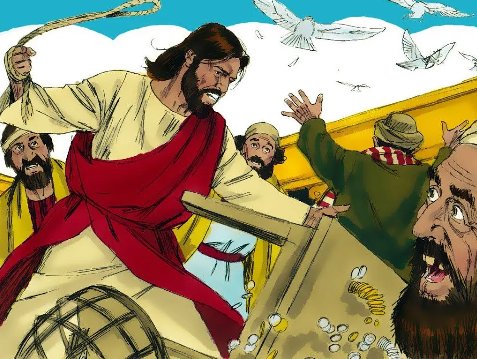 Yah'shua filled with the wrath of Elohim at the vile traders in the temple
Yah'shua filled with the wrath of Elohim at the vile traders in the temple
Babylon in the Jerusalem Temple
Herod was guilty of many heinous sins but this one in particular was the commercialisation of the true religion, which Yahweh also hates...the blending of the sacred with the profane. As I've mentioned to you before in a famous saying: "the Greeks turned the Besorah (Gospel, Good News) into a philosophy; the Romans into an organisation; and the Americans into a business." Indeed, the disgusting Prosperity Gospel is now global, the epitome of Herod's blasphemy and of Babylon itself. And most of the other churches and assemblies are organisations, most of them fossilised institutions, with a great many groups who have turned religion into philosophy - a mere set of mental propositions. Mormonism is a perfect modern example of this, a semi-Christianised version of gnostic-type Freemasonry, whose founder taught that "a man is saved no faster than he gets knowledge (gnosis)" (LDS Doctrine & Covenants/D&C 130:18-19).
Philosophy, Organisation and Money
We need to be careful not to take these observations too far, though, in our enthusiasm to expose error. Every congregation and household needs a sound financial basis. That's what the laws of tithing and stewardship are for. But money is very secondary indeed to the whole Gospel message. Every home and congregation needs to be organised according to divine tavnith (pattern) with the proper officers and accountability structures, yet organisation is very secondary indeed to the whole Gospel message. And the Besorah (Gospel, Good News) has a philosophical matrix for the simple reason it isn't mindless or a matter of blind faith - the Wisdom Literature in our Scriptures demonstrate that much, since philosophy deals with knowledge, mentioned over 130 times in the Bible:
"But grow in the grace and knowledge of our Master (Lord) and Deliverer Yah'shua the Messiah (Savior Jesus Christ)" (2 Peter 3:18, NIV).
Sorting Out the Secondary from the Primary
Philosophy is concerned with the search for 'ultimate reality' (which is what Yahweh's Name means) with the most general causes and principlies of Creation - in other words, for the divine system of 'tavnith'. All of these things are necessary and valid provided we do not seek to be 'saved' by them, whether by knowledge (Gnosticism) or something else. They're all secondary to salvation and a life in the Ruach haQodesh (Holy Spirit). So the Greeks did nothing wrong per se - they just took it too far and as a result were hijacked by the philosophers, allowing the Gospel to be mutated into only a system of thought. The same with the Romans, who made the rapid spread of the Gospel possible - and with the Americans who did the same. So be careful of those who go to the opposite extreme and falsely make out money, organisation and/or philosophy to in some way be sinful or devilish - I have met these very narrow-minded, ignorant, fundamentalist types whose discernment is, as a result, poor. These things are a necessary part of life here on earth.
Correctly Understanding Chapter 11
What, then, does this trampling of the 'Outer Court of the Gentiles', spoken of by John, actually mean spiritually? It means that all those worldly elements that have been 'added' to the Gospel (including pagan traditions) - which Scripture says is to invoke a divine curse - and over-emphasising certain aspects of the Gospel making it unbalanced and ultimately idolatrous, gives the Enemy legal grounds to attack and eventually overwhelm if not cut short quickly upon discovery. The believers who inhabit this 'Court of the Gentiles', spiritully-speaking, are therefore compromised believers - those who have mixed in paganism, commercialism, gnosticism, and confused the love of Mammon (money - Mt.6:24; Lk.16:9,11,13) with sacred worship. And by, in particular, commercialising the Gospel, what believers then do is, in effect, allow the Messianic Community to mutate into BABYLON THE GREAT, which is scheduled to fall (Rev.14:8; 16:19; 17:5; 18:2) as we shall be studying later on in this course.
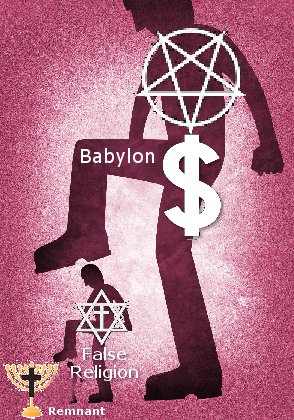 The trampling of the false Christians and true
The trampling of the false Christians and true
For the Love of False Doctrines and Practices
By these means, the Messianic Community (Church) becomes leavened by secular society - the 'system' - and is made progressively more lawless or Torahless until it is fully annexed by, and absorbed into, the satanic globalist empire and one world religion. Clearly what is being referenced here by John's description of the Court of the Gentiles being 'trampled' by the Gentiles, is a description of the fate of all compromised believers - those who adhere to, and love, FALSE DOCTRINES, PRACTICES and TRADITIONS which are not biblical and may likewise be found in PAGANISM, but which they find any number of excuses to continue in - the same excuses made by Israel in the wilderness when they built and worshipped the Golden Calf. Do you remember what their excuse was for doing that? That it was OK because they were doing it 'in honour of Yahweh' (Ex.32:4) and that, they claimed, was what really matters...not the outward forms even if blatantly pagan. In other words, they made their subjective hearts or feelings the deciding factor, not the objective truth of the Davar (Word).
Consequences of False Reasoning
This kind of reasoning is used, for example, to justify worshipping on the sabbath on whatever day they like (usually a Sunday or Saturday); reasoning from that illogic, they say it is sufficient to have a 'day of rest' once every seven days whenever you like. I wonder what would have happened had the Israelites in Egypt decided to follow this reasoning, and said they could observe the first Passover whenever they liked? Did the exact day matter? Apparently the destroying malak (angel) thought differently. What if the same logic had been applied to the first Christians assembling at Pentecost to receive the outpouring of the Ruach haQodesh (Holy Spirit)? What if some had decided it didn't matter day they met so long as they had 'a' Pentecost? They would have missed the most important event in the start-up of the Messianic Community (Church) after the Ascension! That's one reason you don't mess with Yahweh's mitzvot (commandments) and change them for personal convenience - you just do them...unless you're a fool.
Christmas, Hanukkah and Exchanging Presents
This should then be a potent reminder that that's exactly what Christians say about Christmas and Messianics about Hanukkah and then justify these by saying it's a great time for 'family togetherness', to enjoy pretty lights...and to exchange presents, or whatever it is they enjoy the most about these festivals. Do you remember who else 'exchanged presents' in the Book of Revelation?... we only recently read about this, remember? You've got it - the folks who celebrated the murder of the Two Witnesses:
"For three and a half days men from every people, tribe, language and nation will gaze on their bodies and refuse them burial. The inhabitants of the earth will gloat over them and will celebrate by sending each other gifts (presents), because these two nevi'im (prophets) had tormented those who live on the earth" (Rev.11:8-10, NIV).
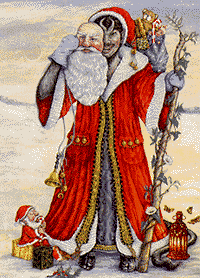
A Meaningless Custom
Now this wouldn'd be an issue were it not for the fact that persons exchanging gifts with each other is a very unusual practice in any culture. Clearly there's obviously nothing wrong in giving gifts to celebrate certain non-religious events but I remember as a boy being puzzled by the notion that people should exchange gifts at Christmas with each other? 'Shouldn't we have been giving our gifts to Christ?' I reasoned, as it was supposedly His birthday. It made no sense to me. Birthday gifts I understood. Gifts to loved ones as spontaneous expressions of love I understood. So under what circumstances that you are aware of do people actually give each other gifts? I can only think of Christmas and Hanukkah, modern Jews essentially borrowing this tradition from orthodox Christians so that their children don't feel left out or disadvantaged during the December holiday season since the two festivals are at nearly the same time of the year. And I remember my first wife telling me how she and her sister bought vinyl records (LPs) for each other at Christmas - identical copies, identical labels - because each wanted the same thing - they knew what their 'presents' were in advance. That's crazy. I remember how, to economise, my mother would save presents that she didn't want and so give them to others the following Christmas. Others did the same thing. Sometimes we used to get our own presents back that we had given folks the year before. It was meaningless and not a little embarrassing at times.
Do Not Love or Follow the World's Traditions
My point being that there is something perverse about 'exchanging' presents, a perversion that has survived into Christmas and has in the last century been passed on to Hanukkah too. And in Revelation 11:8-10 we are shown its spirit. I give this as but one illustration, since we're about to enter the seasons of Hanukkah (in 3 days' time) and Christmas (in in 12 days' time), both of which which are forbidden because Yahweh had banned the celebration of old pagan traditions that honour false gods however re-dressed; and in the case of Christmas, it is the notorious, incestuous antiChrist, Nimrod, whose birthday 25 December originally was...with reincarnation story in the mix too. And I don't care if this upsets anyone who loves this tradition - I just know what Yahweh has told us in the Olive Branch, in Sections 28 and 198, to be exact. All our people ought to be familiar with them. They are the rule of this fellowship so please read them again if you are in any doubt. For Messianic Evangelicals there is no debate. Confronting Christmas and Easter marked the beginning of my exit from the traditions of Christendom. It was a big step at the time but a necessary and important one. Had I not done so, I doubt this ministry would even exist.
Do Not Love the World System
Let take this opportunity to warn everyone what the apostle John himself taught:
"Do not love the world [system] or anything in the world [system]. If anyone loves the world [system], the love of the Father is not in him. For everything in the world [system] - the cravings of sinful man, the lust of his eyes and the boasting of what he has and does - comes not from the Father but from the world [system]. The world [system] and its desires pass away, but the man who does the will of Elohim (God) lives forever" (1 John 2:15-17, NIV).
Beware of compromise and if your feelings are out of alignment with your head, repent!
No Hanukkah in the Torah
Hanukkah is not commanded in the Tanakh (Old Testament) either, Yah'shua (Jesus) wasn't born on 25 December (or 5 January if you're Eastern Orthodox) and we are not required to celebrate His birth. And if we choose to do so privately, as some of us do, then it should be at the right time, at least, in the spring and not (as most messianics believe) in the autumn (fall) either. And that's all I want to say about these two apostate festivals this year.
Awash With False Doctrines & Practices
Christendom and Messianism are awash with false doctrines and practices. The Body is veritably flooded with them making it hard to see the light amidst all the darkness. Believers enjoy the mart that is the 'Court of the Gentiles' far too much - they shouldn't have anything to do with it. Now I have been warning folks about false doctrines and practices for decades so that we can be a clean people enjoying the face of Elohim (God) in our lives. These include:
- 1. Progressive, Postmodernist, Deconstructivist Christianity;
- 2. Liberal Christianity, Naturalism, Deism, Egalitarianism, etc.;
- 3. Talmudic-influenced Messianism, false Sabbatarianism, false festivals (Hanukkah, Purim, Lag B'Omer, etc.), Arianism (which denies the deity of Messiah), etc. (Messianic heresies);
- 4. Anti-Torah Christianity (hyper-grace, antinomianism, false festivals - e.g. Christmas, Easter);
- 5. All forms of Legalistic religion (Gnosticism, salvation by works, etc.);
- 6. False Tongues (gibberish, etc.);
- 7. Perverted Gender Rôles (feminism, matriarchy, abusive macho-patriarchy, forced celibacy, monogamy-onlyism, etc.);
- 10. Prosperity Gospel, 'name it, and claim it', etc.;
- 11. Calvinism, Eternal Punishment & Annihilationism;
- 12. Unitarianism, etc., etc..
The list goes on and on. So what is John prophetically telling us here? He is saying that those who cling on to false doctrines and practices are going to find themselves in the outer courtyard of Herod's temple to be buffetted when it is invaded - their churches and messianic synagogues overrun, their own physical bodies overrun by demons - until they either repent or are destroyed. That process is arguably going on as I speak in the very general sense and has always been going on and will accelerate. Stubborn, proud people will cling onto their totem poles to the bitter end out of a misguided sense of loyalty instead of the horns of the altar.
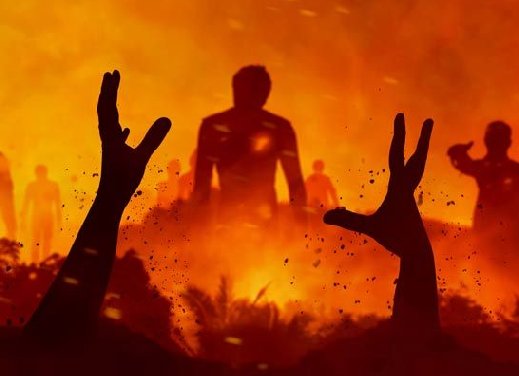
Falling into the Herodian Trap
This is a shocking revelation but it is the truth and we have all fallen into this Herodian trap that is the Court of the Gentiles at some time or another - and remember that King Herod was eaten alive by worms for his blasphemy when he refused to deny that he was a god (Ac.12:21-13). So I think we all need to don sackcloth...and fast because the current Penultimate Judgment, which is foreshadowing for the last time what the Book of Revelation speaks of, is reaching a climax! The worst is yet to come.
When True Words Burn Like Fire
The Gentiles entered the Court of the Gentiles not to worship Yahweh - that pretense has now been dropped - but to trample it, in chapter 11. And no wonder, then, that a Third Woe remains to come for such rebellion and blasphemy! But while there, these pagans will encounter two extraordinary persons, as we do too, as it were, when confronted by the nevi'im (prophets) and the Law (Torah) of Elohim (God). The words of the nevi'im (prophets) burn as with fire! Those in the Court of the Gentiles will hear the preaching of Yahweh's avadim (servants), both of whom they despise, but can do nothing about silencing them, because Yahweh is with His ministers.
The result, in practical terms, will be death for false preachers and their eager hearers and imitators alike. Do you remember the recent vision I shared with you of the preacher being hurled from his pulpit into the air to preach no more? That's what this means. The two witnesses will have miraculous power, to stop the rain (like Elijah - 1 Ki.17.1; Jas.5:17) and to bring fire upon their enemies (like Moses - Lev.10:1-3). But they will finally be killed when their testimony is concluded, like the nevi'im (prophets) and apostles of old. John, of the original Twelve Apostles, escaped martyrdom through they did try to kill him by boiling him alive in oil, according to one tradition. Like I said last week, persecution and martyrdom are components of true discipleship - persecution that Christ and the apostles guarantee (Mt.5:10,12; 10:23; 24:9; Jn.15:20; 2 Tim.3.12; 1 Thes.3:4; 1 Cor.4.12; 2 Cor.4:9; Heb.11:37), with martyrdom always a possibility.
Thaumaturgised or Resurrected?
So let's continue summarising chapters 10 and 11 to end today's message that comes to a climax in the martyrdom of the Two Witnesses. To the horror of those exchanginig gifts, in Christmas-fashion (almost a picture of modern virtue-signalling to show compliance with the state's mandates, come to think about it), to celebrate their death, the witnesses are raised from the dead by the Chayim- (Life-) giving Breath of Elohim (God), and we must assume that they were instantaneously resurrected though it is possible they were temporarily thumaturgised or restored as mortals, like Lazarus, until the First Resurrection of the Bride gets underway. It makes more sense, I think, to conclude they are raised immortal as this is about the time of the First Resurrection anyway - that's more in line wirth the divine economy. The moment the ascension of the Two Witnesses takes place, reminding us of Yah'shua's (Jesus') own Ascension (Ac.1:11), the second severe earthquake occurs with a tenth of the city of Jerusalem's buildings and/or 7,000 of its population being destroyed.
The Two Witnesses as a Type of Messiah
It would be remiss of me not to dwell for a moment on the similarity of the fate of the Two Witnesses and that of Christ. In reading this it would have been impossible for those first believers to not recall the crucifixion, resurrection on the third day (not after three 24-hour periods or three days) in this very same city. Indeed, John is at pains to remind us that this was the city where the Master was likewise killed and raised. Moreover, you will recall, an earthquake coincided with Yah'shua's (Jesus') own death (Mt.27:51). Also, neither His resurrection nor ascension were witnessed by the general public but only by believers. Here it's the opposite - everyone (or at least a large number of adversaries) witness the Two Witness' resurrection and ascension which is to their condemnation as they are then marked as murderers and know it. When this latter-day event actually happens, everyone will recall the parallel with Yah'shua's (Jesus') own murder, resurrection and ascension, and thereby be made aware that they are unsaved and in serious, serious trouble.
Days, Months, Years and Daniel's 'Seven'
Last of all, we were confronted with the triple mathematical connundrum of 1,260 days, or 42 months, or 3½ years. We are going to encounter these figures in succeeding chapters where they are linked to the duration of the 'Great Tribulation' or 'Great Trouble', another area of great controversy as many link it with the 'half week' predicted by the navi Daniel (Dan.9:27) with the precise meaning being obscured by our translations. And as far as I have been able to discover, only the New International Version (NIV) has got the translation correct when it says that "[the Anointed One] will confirm a covenant with many for one 'seven' (not 'one week'). In the middle of the 'seven' he will put an end to sacrifice and offering. And on a wing [of the temple] he will set up an abomination that causes desolation, until the end that is decreed is poured out on him" (Dan.9:27, NIV). But we'll examine that more closely when we come to it - I just wanted those students of prophecy among ypu to make a mental note of that. This is an extremely complicated prophecy because it operates on many levels. More anon.
Shortening of the Days
At any rate, the 3½ years the Two Witnesses prophesy, and the 3½ days they lie dead on a street in Jerusalem, are very brief periods of time and recall's Yah'shua's (Jesus') own prediction that nightmare the non-raptured (that's everyone) qodeshim (saints, set-apart ones) would be kept short when He said:
"If those days had not been cut short, no one would survive, but for the sake of the elect those days will be shortened" (Mt.24:22, NIV).
The Beast
Last of all, this 11th chapter makes first mention of the 'Beast' who figures so largely in the next (and final) Interlude (#III) in the ongoing story. More about him to come...
Conclusion
Brothers and sisters, if you're compromising with the world in any way - and that includes having a love of Christmas and Hanukkah - then you're likely still in the Courtyard of the Gentiles (if you know the truth about these pagan festivals) and refuse to quit - know, then, that you are being readied for trampling. Do you think me harsh for saying this? Maybe you should read your Bibles again with unblinkered eyes. So on that note we will end today. In a couple of weeks' time we shall return to the last (or 7th) of the Shofar's (Trumpets) and the last (or 3rd) of the Woes, Yah willing and health permitting. So until we assemble again next Sabbath, Yahweh bless you all, stay away from Hanukkah (if you're Messianic) and Christmas (if you're orthodox Christian) - make the decision to abandon Hanukkah and Christmas and align yourself instead with the rhythm, flow and pattern of Yahweh's True Festivals which all point to Christ! Amen.
Continued in Part 42
Acknowledgements
[1] Tom Wright, Revelation for Everyone - The New Testament for Everyone Commentary Series, Vol.19 (SPCK, London: 2011)
[2] E.W.Bullinger*, Commentary on Revelation (Kregel Classics, Grand Rapids, Michihan: 1984)
[3] David H. Stern, Jewish New Testament Commentary (JNT Publications, Clarksville, Maryland: 1992)
[4] ESV Study Bible (Crossway, Wheaton, Illinois: 2011)
[5] The NIV Study Bible (Zondervan, Grand Rapids, Michigan: 1995)
[6] Ed. J.R.Dummelow, A Commentary on the Holy Bible (MacMillan, London: 1909)
[7] Kevin J. Conner, The Tabernacle of Moses: The Riches of Redemption's Story as Revealed in the Tabernacle (City Christian Publishing, Portland, Oregon: 1976)
[8] Kevin J. Conner, The Tabernacle of David: The Presence of God as Experienced in the Tabernacle (City Christian Publishing, Portland, Oregon: 1976)
[9] Kevin J. Conner, The Temple of Solomon: The Glory of God as Displayed Through the Temple (City Christian Publishing, Portland, Oregon: 1988)
*E.W.Bullinger was a brilliant Anglican clergyman and scholar whose works merit careful study by serious students of the Bible. He was, however, seriously in error in at least three main areas, namely, (1) he believed the 'Church' has been raptured before the Book of Revelation opens, (2) he believed that the 7 churches in Revelation 2-3 are 7, literal Jewish churches or assemblies yet to come, and (3) he believed in a pre-tribulation, pre-millennial rapture.
APPENDIX
SYNOPSIS OF REVELATION 6-16
The Seven Seals
- 1. White horse - military aggression
- 2. Red horse - bloodshed
- 3. Black horse - famine
- 4. Pale Green/Blanched/Pallid/Sickly-looking horse - disease, epidemics
- 5. Persecution & prayer
- 6. Tremour & terror
INTERLUDE I (Ch.7)
(The 144,000 Redeemed)
- 7. Silence in heaven, listening to prayers which are then answered in a final catastrophe: a severe earthquake I
The Seven Trumpets/Shofars
- 1. Scorched earth
- 2. Polluted sea
- 3. Contaminated water
- 4. Reduced sunlight
- 5. Insects and plague (for five months) (1st Woe)
- 6. Oriental invasion (200 million army) (2nd Woe)
INTERLUDE II (Ch.10-11)
(The Malak with the Little Scroll)
(The Two Witnesses)
- 7. The Kingdom comes, the world is taken over by Yahweh & Yah'shua (Jesus) after a severe earthquake II (3rd Woe)
INTERLUDE III (Ch.13-14)
(The First & Second Beasts)
(The Lamb & the 144,000)
(The Messages of the Three Malakim)
The Seven Bowls/Vials
- 1. Boils on the skin
- 2. Blood in the sea
- 3. Blood from the springs
- 4. Burning by the sun
- 5. Darkness
- 6. Armageddon
- 7. Hailstorm (OB 368:11-12) and severe earthquake III, leading to international collapse
 Click the image for the whole Series
Click the image for the whole Series

 V390
V390
|


